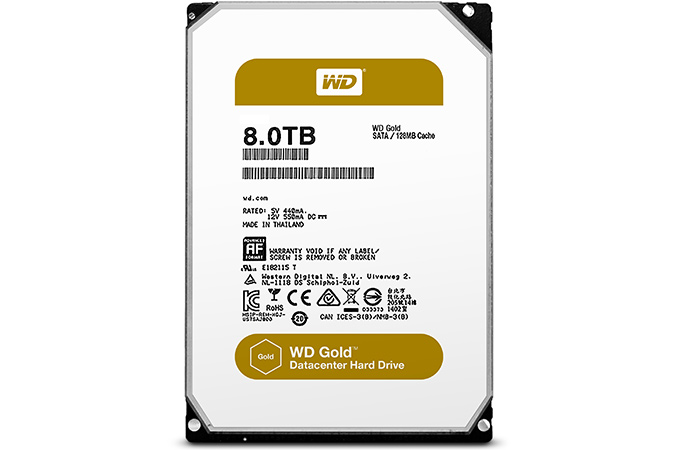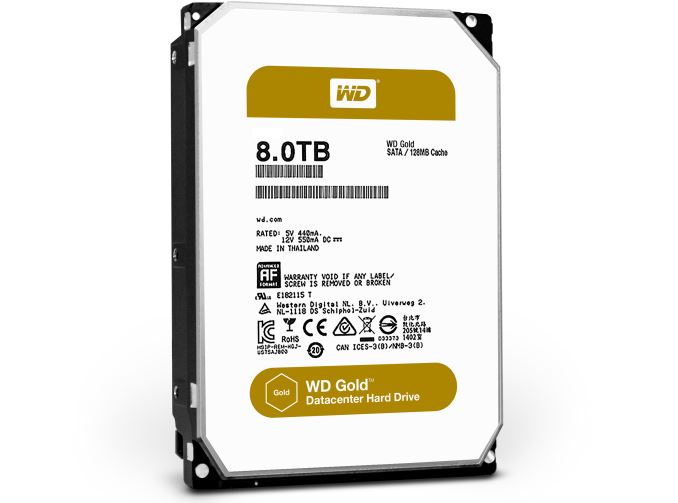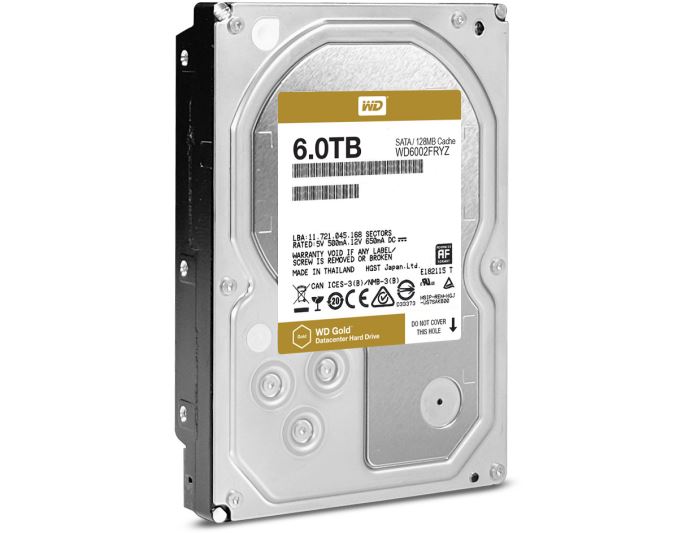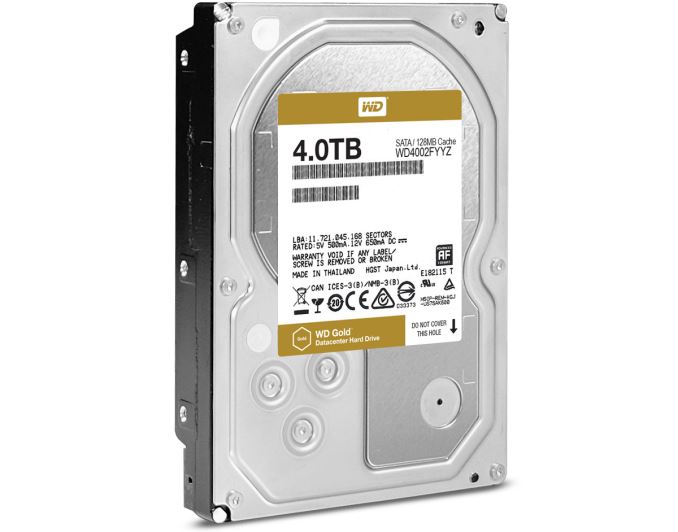Western Digital Introduces WD Gold HDDs for Datacenters
by Anton Shilov on April 19, 2016 9:10 AM EST- Posted in
- HDDs
- WD
- Western Digital
- Enterprise
- WD Gold
- HelioSeal

Western Digital has announced a new family of hard drives specifically for data centers. The new WD Gold HDDs will feature multiple technologies that the company uses to build other drives, including helium and large caches. The WD Gold HDDs will co-exist with the company’s WD Re drives for some time, but as the new family expands, it will eventually replace the previous-gen devices.
The initial WD Gold family will consist of three models: with 4 TB, 6 TB and 8 TB capacities. All three drives seem to be based on different platforms and on different platters, but all of them have 7200 RPM spindle speed and feature new-generation electronics, which is claimed to improve power efficiency by up to 15% according to WD. The new drives come in a 3.5” form-factor and will use SATA 6 Gbps interface exclusively at this point. The WD Gold HDDs are designed for a variety of applications, including small to medium-scale enterprise servers and storage, as well as rack-mount data center servers and storage enclosures.
| Comparison of Western Digital's WD Gold HDDs | |||||
| WD8002FRYZ | WD6002FRYZ | WD4002FRYZ | |||
| Capacity | 8 TB | 6 TB | 4 TB | ||
| RPM | 7200 RPM | ||||
| Interface | SATA 6 Gbps | ||||
| DRAM Cache | 128 MB | ||||
| NAND Cache | No | Yes | Unknown | ||
| Helium-Filling | Yes | No | |||
| MTBF | 2.5 million | ||||
| Rated Workload (Drive Writes Per Day) | 0.189 | 0.251 | 0.377 | ||
| Equivalent of 550 TB of Writes per Year | |||||
| Acoustics (Seek) | 36 dBA | ||||
| Power Rating | 7.40 W | 9.10 W | |||
| Warranty | 5 Years | ||||
| Price | $629 | $499 | $309 | ||
| $0.0768 per GB | $0.0812 per GB | $0.0754 per GB | |||
| 13.02 GB per $ | 12.31 GB per $ | 13.26 GB per $ | |||
Being data center-oriented HDDs, the WD Gold hard drives are optimized for RAID environments and they support enhanced RAFF technology that protects against vibration (by monitoring linear and rotational vibration in real time) as well as head positioning system with two actuators, which improves positional accuracy. The drives also support WD’s time-limited error recovery technology (TLER), which prevents drive fallout caused by extended HDD error recovery processes.
The flagship WD Gold hard drive with 8 TB capacity is Helium based, similar to the HelioSeal platform originally designed by HGST. Western Digital does not reveal the number of platters inside the drive but confirms that these are PMR (perpendicular magnetic recording) platters. Using helium rather than air between the platters helps to reduce power consumption of HDDs compared to non-helium models due to the lower drag force coefficients of helium compared to air - this allows for less friction between heads and the air, as well as platter spinning. All WD Gold HDDs are rated for 2.5 million hours MTBF to signal high reliability.
Next up is the WD Gold 6 TB HDD, which uses a more regular HDD arrangement in air, but which features a media-based cache to improve random write performance over the previous generation WD Re 6 TB hard drive. WD is claiming up to 30% better random write performance. Western Digital does not reveal a lot of details about its “media-based cache”, but it is logical to assume that it uses NAND flash memory as a write buffer which then spins down onto the platters during downtime. Unfortunately, we have no idea about its capacity or actual performance. The drive features modern PMR platters and it may be the world’s first data center-class hybrid HDD (with rotating media as well as NAND cache) for nearline applications. It is interesting to note that also the drives are sold under the WD trademark, they have HGST's markings, which may mean that they were developed by Western Digital's Japan-based subsidiary.
The entry-level WD Gold 4 TB model is claimed to offer up to 18% sequential performance improvement over previous-generation WD Re 4 TB data center drives, but the company does not reveal whether the new HDDs also feature any media-based cache, or its performance advantages are a result of the new electronics, new platters, and/or a new controller. Just like the 6 TB model, the WD Gold 4 TB has HGST Japan marking.
The new family of WD Gold hard drives demonstrates how Western Digital can build HDDs that are tailored for particular needs, which is becoming more important in an industry that is seeing unit volumes decrease over time. The flagship WD Gold 8 TB is optimized for lower power consumption and higher capacity, whereas the mid-range WD Gold 6 TB is optimized for performance.
The new WD Gold HDDs are available at select distributors and resellers in the U.S. as well as from the company’s online store.
Source: Western Digital













30 Comments
View All Comments
JoeyJoJo123 - Tuesday, April 19, 2016 - link
Everyone here remembers.Hard drives really don't offer as much value they used to.
I used to recommend RAID 0 and/or Velociraptors for quicker large capacity storage, particularly for people who wanted to load Steam games quick but didn't want the fuss of migrating games back and forth between SSD boot and HDD storage. Not anymore when you can just get any single large capacity drive and a small sized (120GB~240GB) SSD and use the SSD as cache for the larger capacity drive via Intel RST.
I used to recommend RAID 0 WD Blacks for people that needed large scratch disks for recording or video work. I just recommend RAID 0 SSDs of the largest capacity they can muster.
I used to recommend people get quality series hard drives (Spinpoint F3, Black, Barracuda, etc) over dirt-cheap hard drives (Most Toshiba variants, most Hitachi variants), but nowadays I just recommend people install only SSDs into their systems and buy an external hard drive for mass storage. Not only are externals commonly cheaper than internal bare drives at the same capacities, but they're both just as likely die (i recommend using Dropbox or another cloud storage service to be setup as automatic backups) and at least the external is portable while the internal is not.
Hard drives are just... dead. Helium filled drives aren't a game changer if they can't provide larger capacities at lower prices. The "Gold" drives won't be a game changer either. SSDs are hot on HDD's heels on the only thing they have going for them still; they're still barely the most economical option for high volume storage. (Ironically in an age where almost everything is online in some form or another, and users really can go without mechanical hard drives in their machines and still be OK.)
bsd228 - Tuesday, April 19, 2016 - link
If you're talking about what drives people are putting in "their machines," a story on data center storage is not relevant. Or phrased more correctly - your thoughts (and others) on the death of PC storage doesn't belong here.SSDs are not replacing cloud storage any time in the foreseeable future.
JoeyJoJo123 - Wednesday, April 20, 2016 - link
Just FYI, I don't really care whether you believe my comment belongs or doesn't belong here. I posted it because they were my thoughts and I was going to share them, which is exactly what I did.You saying it doesn't belong here isn't going to change the fact that I posted that comment or the fact that I will continue to post my thoughts wherever I see fit.
However, you can follow what you preach by going ahead and exercising your own self-imposed limitation on freedom of speech on relevant subject matter.
zodiacfml - Friday, April 22, 2016 - link
This one you will have to watchout. SSDs beat HDDs for density which happened too early than I expected. SSDs don't need to match the pricing of HDDs in the enterprise or cloud environment."SSDs are not replacing cloud storage any time in the foreseeable future."
asmian - Tuesday, April 19, 2016 - link
It's a shame the most important metric isn't listed here - the BERR (Bit Error Recovery Rate). If they are migrating marketing-wise from RE to this then it would be good to have confirmed that this is at least as good as the RE drives. I can't find the information on their now very dumb website either - no formal datasheet apparently linked from the drive descriptions. :( I guess if you make no formal written promises of drive quality, you can't be sued...As for SSD over spinning rust, I'd hate to be the client of one of these loudmouth SSD-only evangelists who is NOT reminded that data on SSDs dies after quite a short time without power applied, where magnetic hard disks retain data pretty much indefinitely. Use cases vary, and true cold storage, bulk or not, will remain useful for many - SSDs cannot cut it there.
monsted - Wednesday, April 20, 2016 - link
Hard disks have fairly limited data retention times too. Recommended cold storage time is at most six months for SSD, around two years for hard disks, but decades for tape (usually around 50 years).MrPoletski - Wednesday, April 20, 2016 - link
Yawn.why would anyone, ever, now buy a mechanical HDD for enterprise applications over an SSD?
I don't care if they are cheaper, they consume 5-10x the amount of electricity which makes them more expensicve in the long run. They also fail a ton more, are a FUCKTON slower and now you can even get SSD's that are twice this size (16tb SSD's are here, just not quite in the shops yet, a bit like these gold drives) and bigger are coming.
WD, why the fuck didn't you jump on the SSD bandwagon? I used to love your HDD's they were fast and awesome.
Now you just look like Kodak claiming the didigtal camera is just a fad.
vladx - Thursday, April 21, 2016 - link
WD is already on the SSD bandwagon, they are buying Sandisk.SpetsnazAntiVIP - Wednesday, April 20, 2016 - link
Data center drives only offered with SATA? Not SAS? Am I missing something?sivaplus - Thursday, April 21, 2016 - link
The days where we wanted to have super redundancy for availability (controller, Backplane, Cable, CPU) are over everything we are moving to is server wise redundancy as this turns out to be much more efficient. See windows server 2016 high availbility - uses common buses and inexpensive pools to present software defined storage.Check VMWare EVO:Rail - SAS + Proprietary tech etc and slow in adoption except for fanboys and people with huge Dell discounts.
Nutanix are moving to SDS as well - just introduced a SDS solution based off StorPool - A bunch of HDDs + SSD (PCI-E if you like).
So SDS is the solution here - there you don't need SAS at all :)